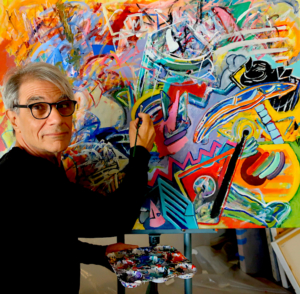Isolating The Apocalypse and The Unique Image
At the beginning of my professional career, after graduating Yale University’s School of Arts MFA program, my artists soul was torn between Flemish painting of the 15th-16th century and the ideas imbedded in the 20th century DADA art movement. Specifically I was drawn to the Apocalyptic visions of artists like Van Eyck, Bruegel and Bosch and simultaneously to the anti-art of Marcel Duchamp and Francis Picabia. It was an interesting tension that you can see in some of the early works. The challenge with these early works was to eliminate the esthetic values of the past but to keep some dynamic ideas like distorted space, use of non-light, contradicting ideas, and the display of phycological visual presence as tools to move forward. In my early paintings like The Descent you can see the dense iconographical elements being crushed over time similar to Van Eyck’s packed hell in his Last Judgement. Later works like The Death of Pan or Tigers Dancing in Front of William Blake have machine elements borrowed from Piciabia, but are used here to enhance a different kind pictorial tension. The result of this long term experiment was to exit from the past, isolate the apocalypse, but borrow some of its dark power and embrace experimental painting. To paint something new and significant and above all to create new imagery leaving the traditional struggle between form and content to the academics.
One important exploration that followed this new thinking were the neo-futurist paintings. (Futurist Time Crash and Little Egypt shown here). Both are super-charged color paintings with spiraling motion that drive the experience. They dance around the idea of dynamic of motion produced by unseen machines and spinning vortexes. Constant intrinsic movement become the actual unique image. This opened the door to artistic liberty.
In some of the newer paintings like The Queen’s Gambit and The Shirt Enters the Chariot Race, the point is to confront and undermine the viewer but still draw their attention. The compositions borrow from medieval illuminated manuscripts, images from the pop-culture, science fiction, space travel, rocket machines, history, abstraction and invention. Hopefully the viewer enjoys them but more importantly they make you think and ask questions, the point of confrontation. Many more explorations continue, including the present, where I turn the idea of visual language inside out with the use of dark humor. I believe now for my art, to move forward, has to confront and invent in order to be unique. And making it beautiful and ambiguous can’t hurt either.
Peter Bardazzi is a contemporary artist who works primarily in painting, drawing and collage and experiments with mixed media. Bardazzi became well known for his neo-futurist paintings of the 1970’s. His work explores visual metaphysics, cultural signals, and contradictions in art and society. Peter received his MFA from Yale University and a BFA from Pratt Institute. Mr. Bardazzi has participated in numerous important museum exhibitions including the 21st Century Museum of Contemporary Art, Japan, the Whitney Museum of American Art, the Indianapolis Museum of Art, Museo Nacional Centro de Arte Reina Sofía Spain, and the Brooklyn Museum of Art. His art is in the public collections of the Museum of Modern Art NYC, The Neuberger Museum of Art, American University Museum, Washington DC, The Library of Congress, The Baltimore Museum of Art, JP Morgan Chase, The Smithsonian Institute of American Art, Wesleyan University and Rockefeller University. You can contact him at bardazzi.com and find his work at @bardazzipeter. His email is .





